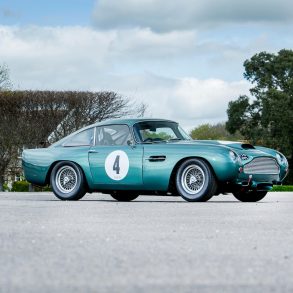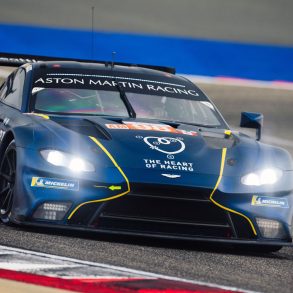
Touring built a pair of two-seater prototypes, one right- and one left-hand drive (‘266/1/R’ and ‘266/2/L’ respectively) which were displayed at the Paris, London and Turin Motor Shows in 1966. The struggling Italian firm was already in receivership and closed at the end of the year, making these unique Aston Martins the last of its important commissions.
Touring’s Superleggera-bodied prototype ‘266/2/L’ had appeared on the Aston Martin stand at Earls Court, alongside the DB6 Volante, wearing ‘DB S’ number-plates, this break with existing nomenclature being justified by the fact that the ‘fast two-seater’ was intended for only limited production. Logically, the mainstream production model that followed should have been called the ‘DB7’, but by the time it appeared in 1967 the press and public had got used to the name ‘DBS’, which was duly retained for the William Towns-designed four-seater. To avoid confusion, the Touring two-seaters were subsequently re-designated ‘DBSC’ by the factory.
Aston Martin’s first two-seater since the DB4GT, the DBSC used a shortened and modified DB6 chassis, which had been re-engineered to accept the De Dion-type rear suspension that would appear on the production DBS. According to the AMOC, the stock wheelbase was retained but the six-cylinder engine was mounted 10½” further back in the chassis, while ZF supplied the five-speed manual transmission. Nearly 7” shorter and 5½” lower than the DB6, the DBSC was said to weigh around 400lbs (182kg) less than its progenitor. Intended to offer the ultimate in e
Exhibited at the 1966 Turin Motor Show, Touring’s right-hand drive prototype chassis number ‘266/1/R’ is fitted with the 365bhp Vantage C-specification engine, ‘266/2/L’ having the ‘ordinary’ 325bhp Vantage unit installed. The DBSC was purchased by the current owner – an AMOC member and past owner of a DB4GT – from H R Owen. (The first name in the logbook is that of a subsidiary company, Hoffmans of Halifax, which retained the car’s original registration mark ‘R 110’). Retained by H R Owen for publicity purposes, it was the sole example delivered out of six cars ordered, and was reputedly tried out by Twiggy in 1968 but rejected for reasons unknown.
The vendor had gone to H R Owen to sample the current Aston Martins and was offered a drive in the DBSC by the chief salesman. He immediately realised that it was superior in every way to his DB4GT: faster and possessing better brakes and lighter steering, yet at the same time affording greater practicality thanks to the opening rear hatch. The asking price was £8,900 – considerably higher than that of a new Rolls-Royce Silver Shadow! – and the vendor set about trying to work out how he could acquire the car. His offer, which was accepted, was conditional on the sale being completed in April 1969, as he had six cars to sell in order to finance the deal.
The sale was finally concluded as agreed in April ’69, at which time the odometer reading stood at circa 8,000 miles, since when the vendor has added a further 6,000-or-so to the total, which currently stands at a little over 14,000. Early teething troubles meant that the DBSC had to be returned to the Newport Pagnell factory three times to get the brakes set up correctly, but given its prototype status that is hardly surprising. Driven regularly for the first few years of ownership, the Aston has spent the past 36 years in careful barn storage.
Finished in Dubonnet Rosso with tan pigskin leather upholstery, this unique piece of Aston Martin history comes with a copy of old-style logbook, copies of Aston Martin correspondence, current MoT certificate and Swansea V5 registration document. A new spare windscreen is included in the sale also.
Any special coachbuilt motor car is rightly regarded as highly coveted and desirable. It is even more so when connected to one of the most famous marques in the history of the motor car industry. With the other car – chassis no. 266/2/L – now tied up in long term ownership, this example really does represent the only opportunity to acquire one of the legendary DBSCs.
The ex-Turin Motor Show 1966 Aston Martin DBSC Coupe with Coachwork by Carrozzeria Touring sold for £320,500 at Bonhams’ Goodwood Revival sale held September 18th, 2009 at the Goodwood Revival in England. Its pre-sale estimate was £250,000-300,000.
[Source: Bonhams]













Very interesting had not seen it before.
I cannot recal the exact year, but Twiggy graced Anold.g wilson who were in the 60s and 70s, and Aston martin agents in leeds. with the DBSC BUT it was black. what a lovely lady.[and lovely car and what a loveely car] perhaps thats why she refused the red won